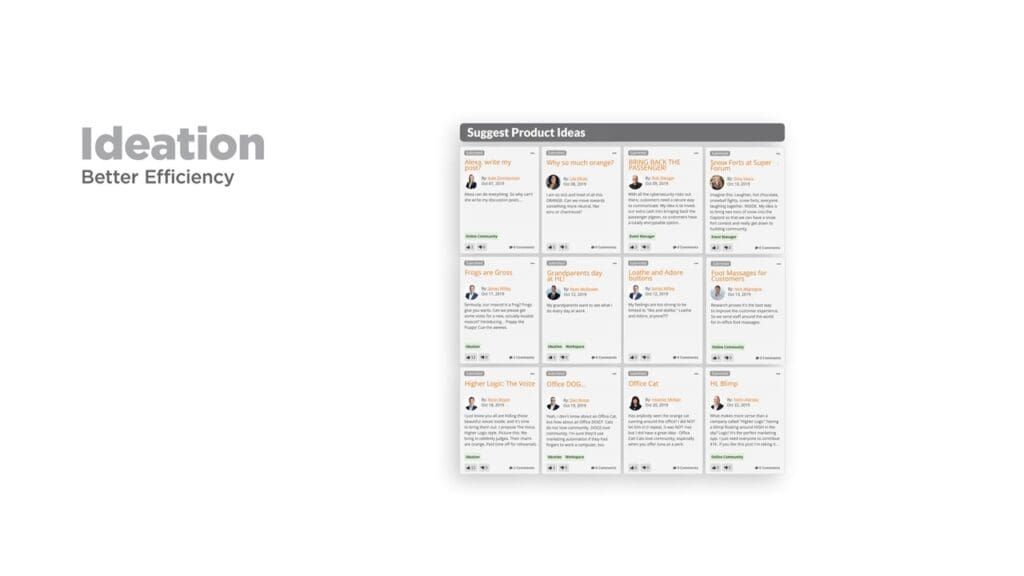
8 Powerful, CX-Transforming Ways to Use Customer Community Data
Do you want to become more customer-centric? Develop better marketing content? Create stronger products? Online community data can help.
When you build an online customer community, you’re gaining an entirely new source of customer data. The conversations, activities, searches, logins (and countless other metrics) provide invaluable data that can help your company improve the customer experience.
Sure, you say, more data about my customers is always great – but what kinds of things can I really do with it, and how does an online community platform help me gather that data?
We’ll look at 8 examples of how to use the customer insights you gain from an online community.
1. Influence & inform product roadmap, enhancements, improvements
With an engaged customer community, you have direct access to the reactions, feedback, and ideas of your customer base to your product and product releases. Let me put it to you another way: Your product roadmap could be directly informed by customer feedback.
Maybe your roadmap is already informed through 1×1 calls or your Customer Advisory Board – but what about all your other customers? What if you had an additional, more organic way to solicit feedback from the entire customer base? Plus, with data around your most engaged community members, you even have the perfect way to identify new CAB members.

Zenoss, a SaaS-based IT operations management platform, has found that their online community is a big help in the product development process.
“For anyone doing agile development, especially SaaS solutions, this is a big deal! We are able to get timely and critical product input proactively from our customers, which reduces support calls to us after the product has gone to production. Customers can try new features and give usability feedback early in the process. Higher Logic enables us to engage customers proactively as part of the development process, which is huge!”
John Boyle, Technology Alliances & Community (former), Zenoss
2. Identify at-risk customers
A community can help you identify at-risk customers. How? A silent customer, although they could be satisfied, could also be at risk of churn. Community engagement indicators can help you have a better sense of how each account is doing. Your online community data can help you parse through those two groups – and tools like automation rules can help get both groups more involved in the online community.
You can build a robust and fully informed health score by integrating community data back into your CRM and customer success platform (like ChurnZero or Gainsight). You could also build community data into a renewal prediction dashboard.
3. Identify advocates
An engaged online community is the perfect space for identifying your customer advocates. When customers start talking, you get to observe who’s a power user and who gives you kudos for a new product release.
And it’s not just a manual process, either. With Higher Logic Community, you can use automation rules to move a customer with a certain number of posts into your advocate pool or assign customizable ribbons or badges based on that activity. Engagement points automatically identify your top users and reward them for their contributions.
4. Guide prospect & customer marketing content
Event content, webinar topics, blog posts, podcast episodes, LinkedIn posts – any of these content channels can be informed by community conversations. For example, if customers are asking each other about a certain product use case, your customer marketing or education teams can turn that into a helpful piece of content to improve product adoption. It also helps you understand what topics your industry as a whole is talking about, helping you to elevate your demand generation marketing.
Review the search terms report within your Higher Logic Community to identify top searches. What are customers looking for and consuming? You might discover topics you hadn’t thought of addressing – and then turn that into helpful, revenue-generating content.
5. Improve customer onboarding & training
With data from your top-searched content and library downloads, you can also identify gaps in your training and educational materials. Are customers consistently looking for a resource that you don’t have? Do they gravitate toward a certain webinar in your library? These types of data points can help you identify what topics are popular and where you may have gaps – streamlining customer onboarding, increasing time-to-value, and contributing to product adoption.
6. Identify sales-ready opportunities
Your online community shouldn’t be a marketing tool, but similarly to #2 (identify at-risk customers) engagement data can also give your Account Managers or CSMs great intel around upsells, cross-sells, and account expansion. Customer conversations, resource downloads, event attendance, can help your account team know which customers are sales-ready.
Your community is also a great space to solicit natural references. Encourage advocates to share their successes – it’s a known fact that we respond best to referrals from friends and family. If your community feels like the safe space that it should be, it’s a great place for customers to learn about other products and solutions.
7. Identify engaged & interested prospects
When you leave part or all of your branded online community open to prospects, they can explore industry conversations, meet your customers, hear from advocates, and learn more about your products – all in an organic, inbound way. When your prospects post discussions or ask great questions, it’s perfect intelligence for your sales team as they reach out to these prospects. Plus, their activity creates great insight for your marketing team to create new content.
8. Improve online community engagement with hot topics & content
Similarly, it’s not just the overall customer experience that will benefit from online community data – you can plug community data right back into the community to make it more engaging.
Let’s look at the example we covered above. If you know customers are downloading a resource on a certain topic, make your next Ask the Expert about that topic or include that resource in your new community member welcome email. Incorporating popular content or topics like these back into your community content calendar will help you replicate what’s working.
Matt Lawson, online community manager at Genesys, implemented a strategy similar to this. He takes the questions that customers are asking in the community, interviews internal experts in a TV-show style format, and then turns this video into another engaging piece of community content.
Plus, your data will help you know when you’re ready to grow your online community. We recommend you start with a single topic community and create sub-communities as you grow, based on the level of engagement you’re getting.
Community Makes It Easy to Get Customer Insight
Are you looking to understand your customers and prospects better? Become more customer-centric? Develop better marketing content? Create stronger products? Grow your revenue? Your online community can help you gather those customer insights through their organic activity.
When should a company build a customer community? Find out if you’re ready for a community with these 9 signs.




